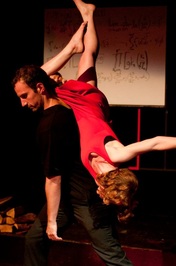 From BURNING UP THE DICTIONARY
From BURNING UP THE DICTIONARY  Not everything I choreograph is violent
Not everything I choreograph is violent Much like my recent articles on HowlRound, I am dealing here with both pragmatic and fightaturgy concerns. First of all, I need to be be able to give the director and the rest of the production team a list of moments in the script wherein I expect to be of service. Some of these are obvious to anyone and might include a stage direction that reads something like, "she draws her sword, running at the bandits and dispatching three of them before facing off for a duel to the death with the bandit king." Others are less blatant and may be moments wherein a line of dialogue such as "Stop that! You're hurting me!" might leave room for interpretation in the staging. I make a special point for looking for slaps and falls, as very often those can be overlooked and cause safety and narrative issues if not addressed. Also, events such as sex scenes can also often benefit from the input of a fight director (I am choosing not to add jokes to that last observation).
As I also bill myself as a Movement Specialist and as that sort of work comes into play in many productions, I am also examining the play for any moments wherein actors might need coaching for other elements of physical storytelling. I look for incidents such as when characters pantomime any sort of behavior, if a character has any sort of seizure, as well as any opportunities for abstracted movement.
Now then, identifying the moments in the script that will (or may) require attention is only the first step. One must also read for clues and references for how and why those scenes happen. A play may have a single slap as the only fight, but that slap is very likely an emotionally loaded movement based on other events in the play. In Act II, Scene IV of Romeo and Juliet, Mercutio gives a disparaging account of Tybalt's fencing. This is both an opportunity for composing comic movement for that moment, and an indication of what might happen when the fight itself takes place later. Also important when reading the play is to get an idea for how intense the violence itself should be (I have a personal scale that may be the subject of another post one day).
Additionally, I read for fightaturgy clues that are NOT related to any physical altercations but add to character and narrative. If I were to be engaged for a production of The Mikado for example, I would ask for a moment early in the process to work with anyone in the cast who might have a sword as part of their costume. From my own production experience; When I worked with Company One on Bengal Tiger at the Baghdad Zoo there was a discussion of how the US Marine characters would handle their rifles, and when I did Fool for Love with New Rep, one of my tasks was to help one of the actors learn to use a lasso. While these are not "fights" per se, these elements often fall to the fight director.
From my experience as a playwright; my play, Burning Up the Dictionary, contains a significant comic fight scene that involves abstracted movement (a "Giant Ninja Robot Battle") as well as an attempted slap scripted into the play. There are also opportunities for moments of dance (up to the discretion of the production staff), and a racquetball scene (scripted).
Fightaturgy gets especially important with older texts, and plays that involve dueling traditions in any way (regardless of whether or not a duel actually takes place). A company working on plays from the Spanish Golden Age will most likely come across a great deal of language dealing with the culture of dueling, whether or not there is any actual duel in the play itself. These are all elements that should go both into choreography decisions and be put on the radar of the director and other production team members.
Once I am ready, the document that I send the director after reviewing the script is a notated list of scripted incidents of violence/movement, potential incidents of violence/movement that are not explicitly scripted but may add to the narrative, and notations of moments when the characters reference violent practices and might benefit from a dramaturgical note. I highlight which incidents I perceive as needing priority and/or greater intensity, as well as questions about props, costumes, and directions that the narrative might take because of the violence, or that might influence how the violence might be executed. Each piece is notated with the page/act/scene where it appears in the play, and may also include comments. The list I send the director is an edited version of the list I generate for myself, streamlined for easier understanding. This usually forms the basis for the next conversation I have with the director regarding how they would like the fights to take shape, as well as serving as an aide to planning rehearsal and fight call times.
Like any other design discipline, fight directing begins with an analysis of the script. That analysis becomes the foundation for any work that takes place in the rehearsal room, and later, on the stage itself.
EDIT: This post has been adapted into an article in The Fight Master: Journal of the Society of American Fight Directors
 RSS Feed
RSS Feed